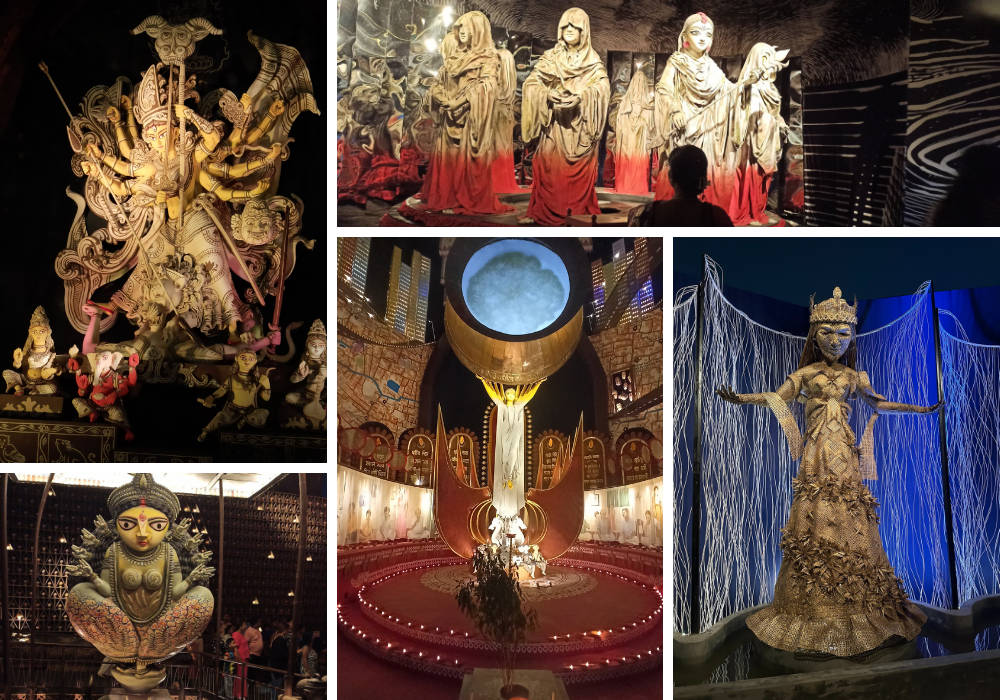[Photos by Natasha Jeyasingh and Ronaan Roy]
For the past two years I’ve been writing for Founding Fuel on the Durga Puja celebrations in Kolkata. For whatever reason, last year’s article blew up (It rose from the top ten search results on the subject to number 1 over the course of the year). So this year as well I set up my family, and my diligent sister, Dana, who acts as guide-driver and companion, and we went on to photograph 150 pandals (we visited a few more than that). If you’re curious to drudge through the 150 they’re available on the highlights section of my Instagram (here).
This year, we’re also graced with additional photographic contributions from the talented and astute Natasha Jeyasingh. A stalwart in the art space herself, she was asked as a guest to Kolkata this year, and was whisked from pandal to pandal before the full force of the festival started. I asked for her (substantially better) photographs and she very graciously obliged.
This year, as many of you know, Kolkata was heaving under trauma. In case you’re unaware, from another country, or reading this many years later, let me give you a quick summary of what happened. For those who are aware, skip forward a paragraph.
On August 9, a trainee doctor, after completing her 36-hour shift, laid down to rest in a seminar hall. The fact that doctors in India routinely have 24-36 hour shifts and have no designated rest areas should be disturbing already. She was raped, brutalized and murdered, and was found the following morning. Her parents were informed it was a suicide. As case facts were revealed, it appears that there were cover-ups from both the police and the hospital. The hospital also has an alleged history of selling medicines illegally (purportedly to Bangladesh) and other issues of corruption that were brought to the public’s attention as a result of the rape. The slowness of cogs of due process turned by a triple combination of investigators, administrative staff and the government stoked frustration and betrayal in an already angered people. Kolkata, and consequently the country and consequently several parts of the world underwent protests, rallies and strikes. The symbol of the movement became a spinal column, with a feeling that those in power were lacking a spine to take action. Currently, several doctors in Kolkata are on hunger strike. As I write this article, the hunger strike is on for 10+ days. Also as I write this, the case facts and a full understanding of the events and cover-ups have not been unravelled. This is also a good time to mention that the views in this article are my own, and don’t represent any organisation I’m affiliated with.
It is in this sombre time melded with heated political tempers and cold anguish that this year’s Durga Puja happened to fall. Durga Puja and politics (as with nearly everything in Kolkata and politics) are interwoven. Many Pujas did not accept the Rs 75-85,000 funding given by the government. Across societies the events that accompany Durga Puja were cancelled. Many places served only niramish food to their patrons, simpler vegetarian food that is normally eaten during periods of mourning.
But Durga Puja remained unconquerable. According to The Times of India, 4 lakh flyers came in, surpassing the previous pre-Covid high in 2019. When I went around there were some foreign folk that weren’t there in previous years. Decorations, though late in starting, adorned to meet these people. Couples on bikes in the wee hours, would go in small by-lanes which are unphotographable during most of the year, but now due to fairylights become the highlight of their instagram. For those not in the know, I doubt their experience would be diminished.
One has to understand that many pandals start their construction as early as April or as late as July. Certainly plans are made, commitments are made, and funding is raised by June. Sponsors play a big part, and sponsors are often shy when it comes to unresolved crimes potentially mired with politics. Sponsors themselves were touch and go for a long time, much of the money coming in extremely late this year.
Pandals are made by committee, and committees have ecosystems. Coming out politically brushes against these ecosystems. At least two Puja pandals that happened to have art-related spines in them (unrelated to the RG Kar incident according to the organisers) were removed from the installation in September. Another art piece that resembled a spine was removed during Durga Puja itself. I suspect that this was a result of political pressure, but I cannot be certain.
So in the end, out of the 150 Puja pandals we visited, a mere five seemed to touch upon the issue (I say touch upon them, because none of them, save one that I could not find, seemed to take the issue head on). If there is political pressure against art being used as protest, it saddens me. It’s a little like stopping someone from wanting to scream.
I won’t call out the pandals by name, in case their subtlety is their attempt at anonymity. I heard that the artist of one of them has quit his government-run art-organisation stating, “Now I have no fear.” One pandal is on women’s empowerment and has a spine subtly integrated into its ceiling. Another is a Bengali funeral home shrouded in white. Both of these had no relation to the themes they had submitted earlier in the year, and neither were ready when they usually are (as compared to previous years), leading us to believe that they changed their themes last minute. I quote from one pandal: “Art should comfort the disturbed and disturb the comfortable.”
But let me not mislead you. Most of the pandals in the city didn’t go near the issue. Many were muted. Some rushed, some modified to make up for less money coming in than expected. Lighting (often the most expensive, and the last item to be installed) suffered the most. Lots of Durga pratimas (the idols) were grey in colour. Perhaps you are wondering why I spent column inches on this subject; it’s because there was an expectation. Durga Puja art is, more often than not, the art of social cause, and often enough the art of outrage. It has handled child-trafficking, refugeeism, labour injustice and other such issues in the past with poignancy and sensitivity. That’s why it’s odd that of all things, this was robbed of a voice, and perhaps the most emotive pandal this year was on a father’s sacrifice (the pandal did not make the top ten). I apologise that I took a disproportionate amount of time to set the social backdrop, and then go on to say the themes took little from it, but without that setting the stage, this article would be remiss.
Anyway, here’s the list of the top 10 (well, there’re actually 12… you’ll see).
10. Thakurpukur State Bank Park (Purnendu Dey)
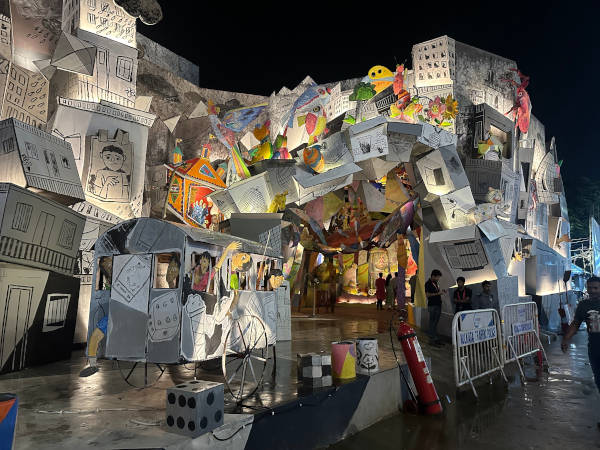
Deciding that children’s art is one of the purest forms, Thakurpukur State Bank Park is a vibrant motley of colours, (as opposed to many other pandals which are low lit with halogen and mood). If Durga Puja Art has converged around a Susanta Paul shaped centre (you’ll understand this reference in a bit), Thakurpukur State Bank Park decided to diverge as far as possible from it.
The pandal is also made in the form of asymmetric paper craft, lending an almost cubic touch to their houses and crab forms (there’s a crab at the entrance, whose perspective amplified claws ooze drama). Round frogs and angular insects abound and drawings of children spill out from every surface. The pratima (idol) and asura (demon) also take on this child-like rendering, though constructed out of clay (probably).
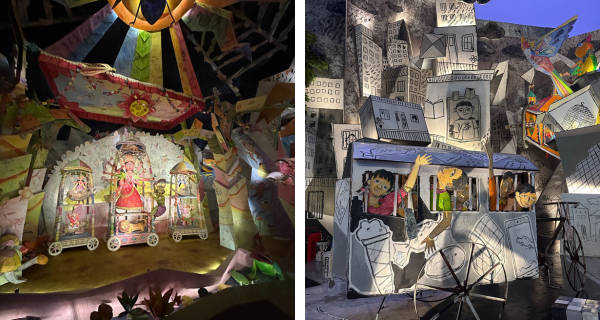
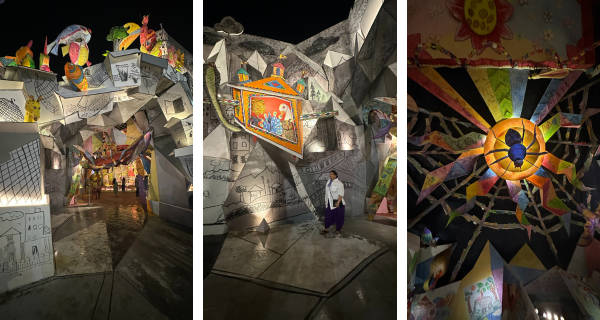
I want to specially call out the spider, who manages to be as menacing as a Disney antagonist should be, while still retaining the same colouring book frenzy and style. His presence particularly gives the pandal depth, rather than retain the same thin emotional spectrum through the piece.
9. Dum Dum Tarun Sangha (Anirban Das)
Dum Dum Tarun Sangha is the first of three top tens that come from this tight little locality. I’ve visited this pandal location in previous years, but this is the first year they’ve chosen to construct their pandal overlooking a waterbody they’ve always had. The pandal itself has buildings interspersed with waterfalls and looks out onto the pukur (small pond), that gives the entire composition a great sense of depth and layout.
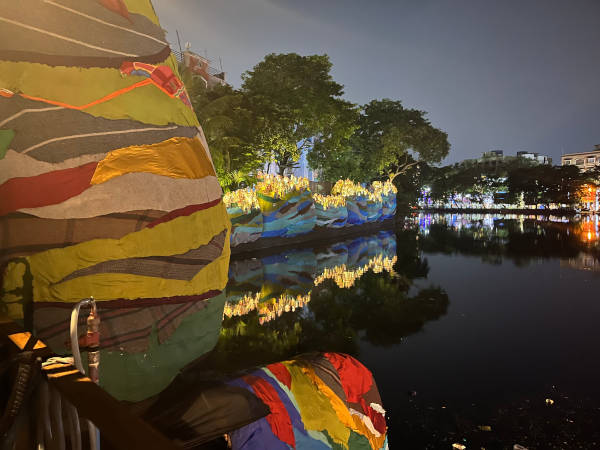
The land that the dainty houses is placed on is actually large rolled up swathes of cloth, resembling the kind of quilt work you see in Rajasthan. Many of the houses are individually lit, with their windows catching the lighting in their reflective surfaces. When you look out onto the water body, these little houses quickly recede in the distance, which is exactly how cities look when you happen to catch a view from a house in, let’s say Shimla, at night.
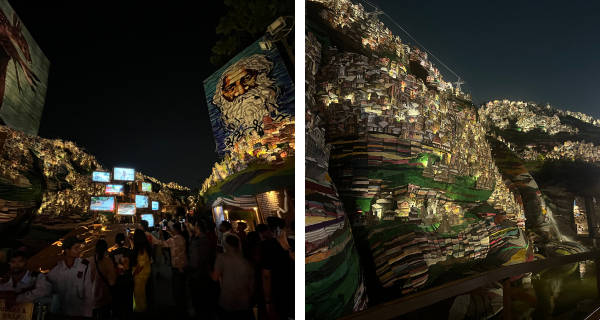
The beginning of this serene little pandal seems a little out of place. It has several TV screens with news channels talking about landslides. However, the houses inside seem at peace. Perhaps it is indicative of how fragile peace can go crashing over the side of the cliff at any time.
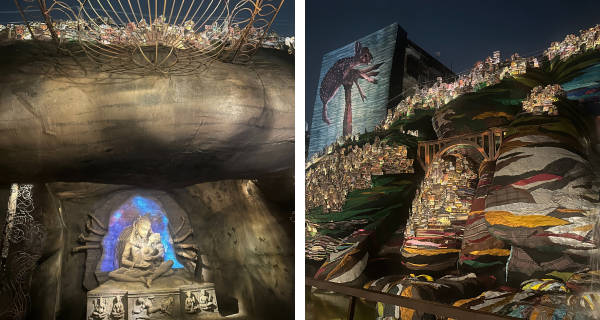
The idol is a Shiva Durga combo, in what appears to be an ancient worship site in an underground cave. They are in an intertwined embrace, presumably because Shiva, and consequently his hair, is responsible for safe-guarding us from the potential flooding of the surging Ganga.
8. Ultadanga Telenga Bagan (Parimal Paul)
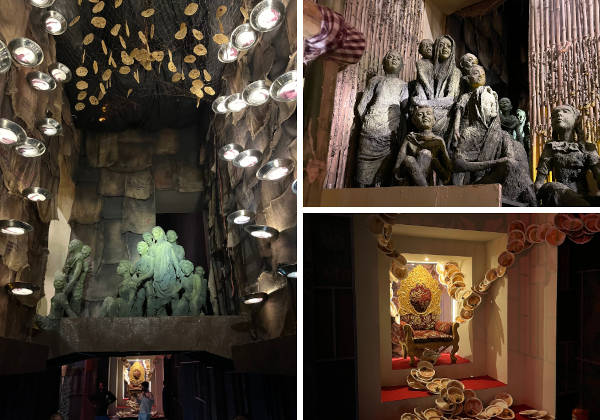
Telenga Bagan chose hunger as its theme. (Actually there were a few pandals where hunger was the theme, I’m not sure what the deal is.) The pandal is filled with grey figurines of indigent peoples. Above them rotis pendulate in and out of reach (below these rotis are the underlit images of people holding out bowls — or we have people’s hands shadowing bowl shaped lights). An installation at the end of the corridor has a wedding throne spilled over with thermocol wedding plates containing wasted food. As you turn the corner you see Durga, the giver of grain, having laid out a rice-plantation. The asura is also a hungry person, perhaps symbolising famine. You notice as you turn the corner, that the aforementioned indigents have bust through the wall, and are lining up to partake of her grace.

There are a few things I’m not sure I understand. One the Durga pratima is the most rotund (though not in an unbeautiful way) that I have seen thus far. I’m unsure what that’s meant to imply. Also the asura (unfortunately I don’t have a clear picture of him) seems to look oddly Shiva-like, down to the snake coiled around him. He’s also reaching out for food it seems. The entire thing is quite beguiling, as well it should be.
7. AK Block (Bhabatosh Sutar)
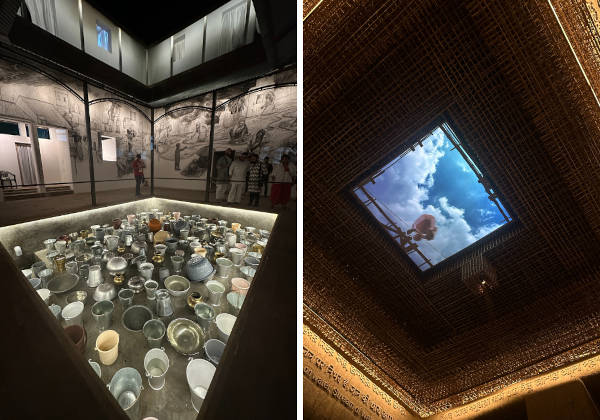
Seventh from the top is AK Block, which had the theme of water conservation. This strikes home, because Kolkata much like other parts in the world is grappling with a groundwater situation. The pandal itself was an incongruous experience. On the one hand the art, the work, the idea of having a man tile the roof of a building in video while you stand underneath, is a mixed bag of sensibilities and finish. But on the other hand, the drops of water playing taal is a stroke of genius, that defies anything we’ve seen before and is likely to be remembered as a highlight for this year. Hang on a second, it has to be seen to be believed.
[The water drops effect]
When I went it was a crowded space, harassed by a whistling management trying to keep the crowd moving, and I could barely hear the sound. But Natasha Jeyasingh (if you see cleaner images than usual in this article it’s because her keen eye took them, and I’m forever grateful) managed to capture the unbelievable video above.
I’m told by the artist that the water droplets are computer programmed onto the various vessels to get the sound that we hear. There was no amplification or microphone anywhere near it. This hopefully puts to rest the speculation that it’s a recorded sound and dropping water accompanies it. And we can all join together to celebrate the true ingenuity behind this awesome idea.
6. Dakshindari Youths (Anirban Das)

Dakshindhari Youths celebrated 100 years of filmmaker Tapan Sinha. Unfortunately, I have not seen a single film of Tapan Sinha, so I barely have a clue. But lovely lighting, a wonderfully used space and some clever art elements made this one shine. Some beautiful images which are either of his films or posters, and projections of his films, with a combination of stunningly lit installation.
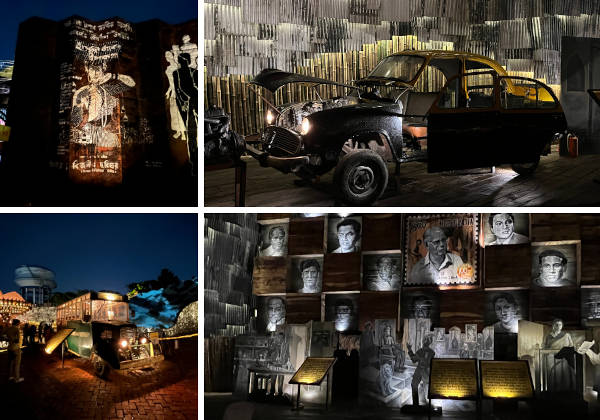
One of the installations is an old Dodge bus which goes from Ballygunge to Howrah. Alongside (I am told) is projected the film where it’s referenced from, 1959’s Kshaniker Atithi. Another is an exploded taxi cab, whose doors and other parts are slightly away from its main body, allowing one to view its inner workings (supposedly this is a nod to a bomb blast in his Calcutta trilogy). I’m sure there are many other elements, along with the giant-sized elephant head into which the pratima is placed, which is also part of the myriad of easter eggs.
5. Susanta Paul (Hatibagan Sarobojonin Durgotsab / Tala Prattoy / Kendua Shanti Sangha)
Fifth from the top is not really a pandal, but an artist and three pandals. Susanta Paul has become an institution in recent times. Last year, he secured the number one spot and a few years ago in Tala Prattoy he had another enormous Shiva head, several stories tall, but in an interior setting making for an unbeatable, unmissable pandal. This year he’s done three.
Unfortunately, having three of his pandals in the top ten was getting repetitive for me to write about. Don’t get me wrong. He’s the nexus of Durga Puja pandal creation at the moment. Of all the artists known in Kolkata, I think his name is the most widespread. Like Van Gogh and Modigliani, his art is recognisable a mile away. But for so many years now, his calling card has been self-coloured metal work and pin-pointed lighting.
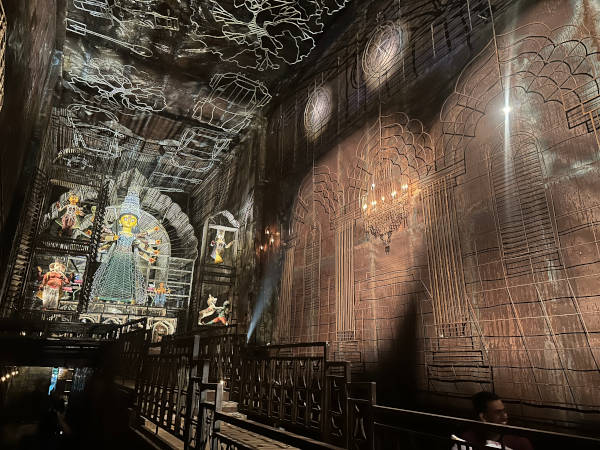
[Intricate ceiling ensign at Susanta Paul’s Hatibagan pandal]
In Hatibagan he creates old housing, whose rooftops are adorned with pin-pricks of light. High Gothic arches and delicate ceiling art adorn. In front of actual buildings, instead of blocking their line of sight, he instals a tall and impressively straight facade that acts as a false front to the buildings.
[Video: The ‘void’ at the Tala Prattoy pandal]
Meanwhile, in Tala Prattoy, his usual playing ground, his theme is the ‘void’. You walk upwards surrounded by his signature metal works, and then as you’ve snaked around that, you are plunged into almost absolute darkness, where only your knees and below are lit with pin-pricks of light. On razor thin string-like material (I think it’s plastic, but I hope it’s not), beams of light, looking like a laser show, are projected from incredibly far away. Then, you come across a projected candle reflected several times (why a candle? I’m not certain I’m convinced with this) and the Durga pratima as a flat sculpture.
If you came across this, without having been suitably exposed to Susanta’s other work, you would be mighty impressed. But unfortunately memories of the majesty he has created in Tala Prottoy tower over this work. I hope he doesn’t catch me and wring my neck, because though I’m criticising, I probably have one-tenth the artistic ability of his little toe.
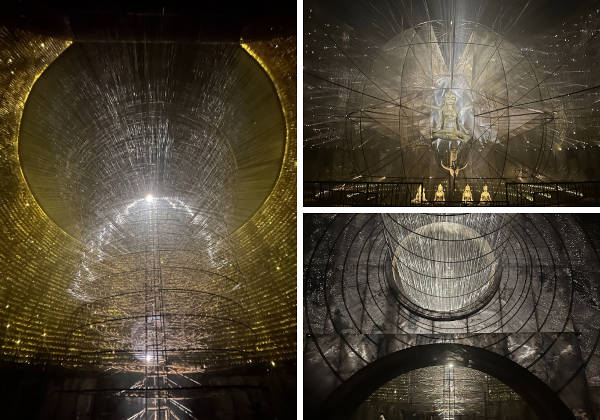
[The Kendua Shanti Sangha pandal, themed “Resonance”]
Kendua Shanti Sangha is therefore his best work this year. Themed “Resonance”, where Tala Prattoy is devoid, Kendua Shanti Sangha shows his intricacy in a fuller form. Once again thin parallel beams of light fall upon thin materials that glisten against the slight particulate movement of the installation. A Tibetan resonant bowl is the basis of the soundscape around you. And then you come upon the Durga pratima, she is levitating in a sphere of perfect harmony. She’s back lit by pin pricks, and if you believe in deities, then glancing upon her is a glimpse into a peaceful heaven. The architecture, though sound, seems to defy Euclidean physics, and thus feels divine. This is the Susanta I all so often sign up for.
4. Behala Club Sarbojonin Durgostab (Pradip Das)
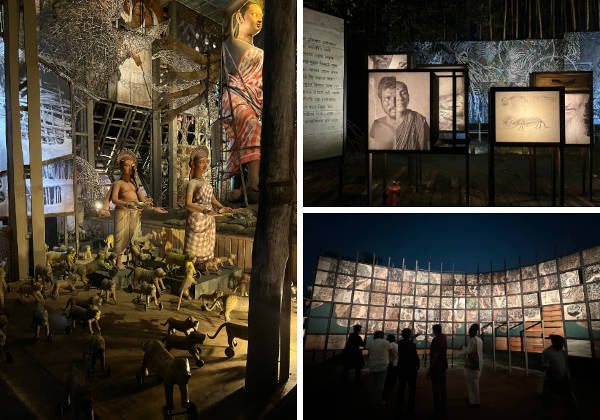
There is a little bit of lore where farmers or fishermen, honey collectors or wood-cutters in the Sundarbans wear a Durga mask on the back of their head. How it took so long for such a simple concept to be translated into a pandal is a head-scratcher (we had two this year). But artist Pradip Das (as he so often does), seeps the pandal in swathes of research around the subject and bathes us in mood and lore.
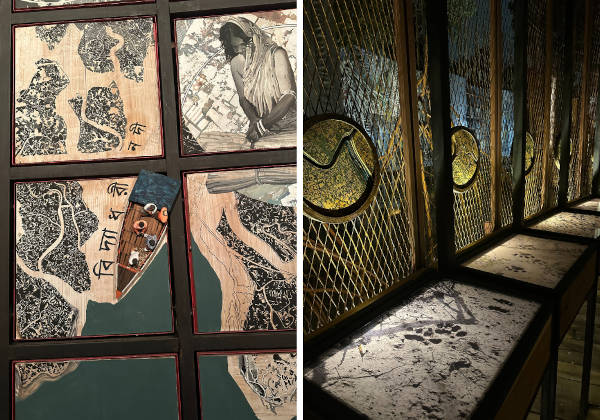
Enter and you see a map of the region. Anyone who knows the Sundarbans knows this map is gossamer, ever changing. By the way, navigating down one of the waterways is a top shot of a boat laden with the artist and his crew. Below the map is a drawer and in that drawer are pieces of artistic representation of animals that live there; crabs or Komodo dragons. To the left are geographies, marked by bends in the tributaries — the last found footprints of the tiger. As you walk ahead you see the images of people, real people of the Sundarbans. Some have scar marks that wind like the river. Another is a half and half, half the image is a woman who attacked a tiger with an axe to protect her husband and the other half is the man she valiantly defended. Turn the corner, and you’ll find the many names of the real tigers that lived there. In ziggurat upon ziggurat of research, the artist builds his art.
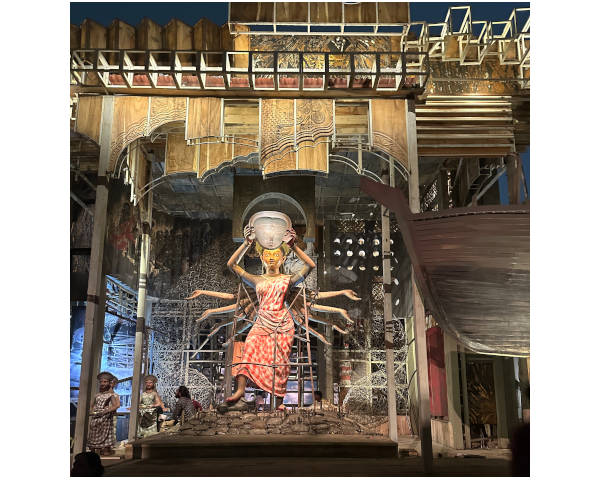
The pratima is Durga holding up a mask. Could it be that you’ve just turned around, to see Durga gently take off your mask, letting you know she’s got your back? Or could it be the mask and the belief in the mask births Durga herself? I’m told by a very capable guide that she is an ordinary woman and the mask of Durga reflects divinity upon her. If you’ve read the correct Amitav Ghosh book, you’ll know that Bonbibi, the semi-deity who transcends the Hindu-Muslim divide, is the lore that turns the Sundarbans into a magic-reality setting, and this pandal manages to capture just that.
3. Dakshinpara Durgotsav Committee (Debashis Barui)
A pandal we’ve never visited before is Dakshinpara Durgotsav Committee in Dum Dum. Because it racked up a new-comer award, we made our visit. We navigated down unmarked by-lanes to come to it, and when we did, we were taken entirely by surprise.
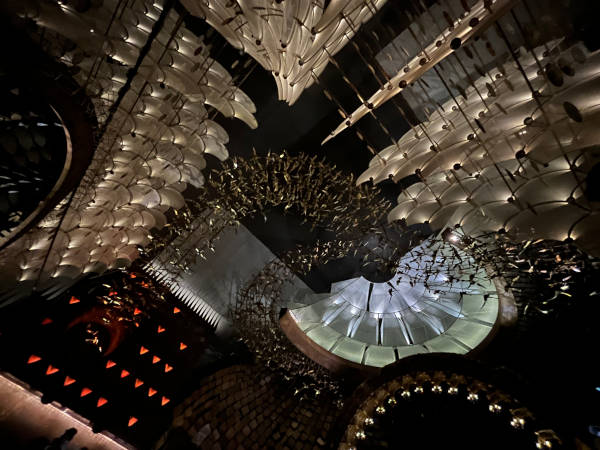
As we walk down the pathway we have mechanical birds on all sides. To the side, we have shadow puppets of these little fellows, and above us, they sway gently, their exposed mechanics explaining how the motion is birthed. The walls become beaten metals, and we’re taken through two or three different settings in the long corridor to the pandal, each bounded by delicate artisanal symmetry. On reflection, the beginning is reasonably humble, perhaps an active choice to contrast the grandeur to come.
Enter the pandal and you’re clear that the pratima is to your left. But your view is blocked by a wall (holding up your mobile phone, your device can overcome this obstacle). But I think you’re not supposed to look left, you’re supposed to look up, where more mechanical birds have a spiral formation overhead. Ahead you have an item that feels like a mashrabiya lattice, whose constituent parts are rotating, offering you just the faintest glimpse of what appears to be a dynamic pratima.
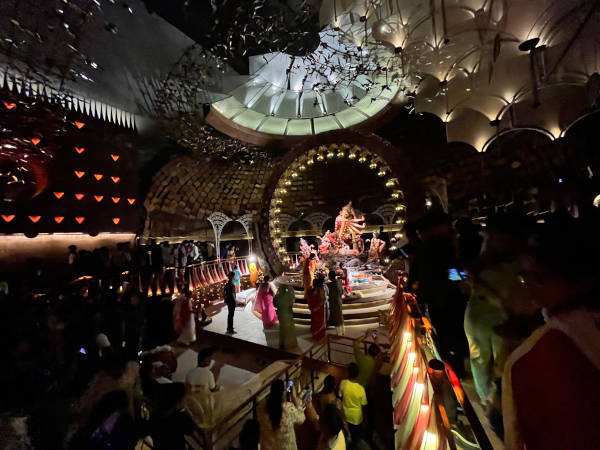
The path leads you to spiral around the pratima, mirroring the circling birds above. Once again, you’re confined by a wall, so the first real look you get of her is the side. It’s now that you see the wheel arch that houses several small chandeliers, is actually rotating around the pratima. You move behind her, and you can see that, like the masters of the universe, she’s unsheathing her trishul, back arched and ready to strike.
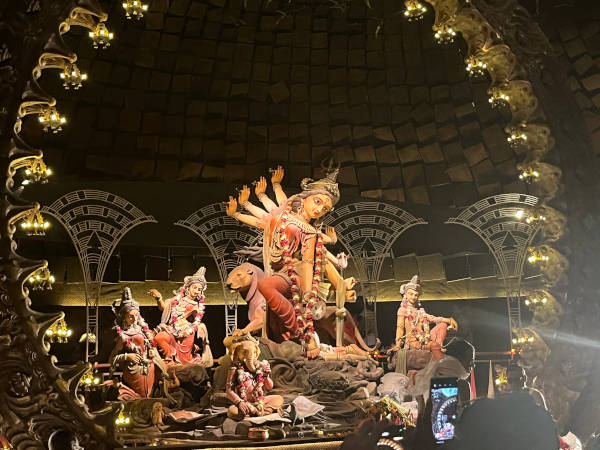
It’s only once you’ve moved around her entirely that you get to see her in full force (from a lower angle now) dynamic and battle-poised like a figure skater. Incredible lighting in hundreds of small sources and a dome-shaped pandal are touches that contribute to the final regality. You may inhale now, lest you’ve forgotten thus far.
2. Alipore Sarbojonin (Anirban Das)
It has to be said that this pandal may be rated high, because my family and I have a soft spot for it, in that it had live actors. Last year, Hatibagan Nabin Pally had live actors and it caused a stir in Kolkata. This year, no less than five pandals had humans as part of the pandals, with varying degrees of acting prowess / engagement. Alipore Sabojonin brought in 80+ actors.
These actors would perform in rotation. I understand that these actors were Bahurupias. Bahurupi is a rural theatre form, Bahu, meaning many and rup meaning form. These actors, mostly male (I think our cast was entirely male, despite a very slender feminine Durga actor who spent most of his/her time on one leg), shift with a combination of mimicry and the ”disguise self” spell and slip in and out of many roles. Ornate make-up and bold costume choices are a trademark.
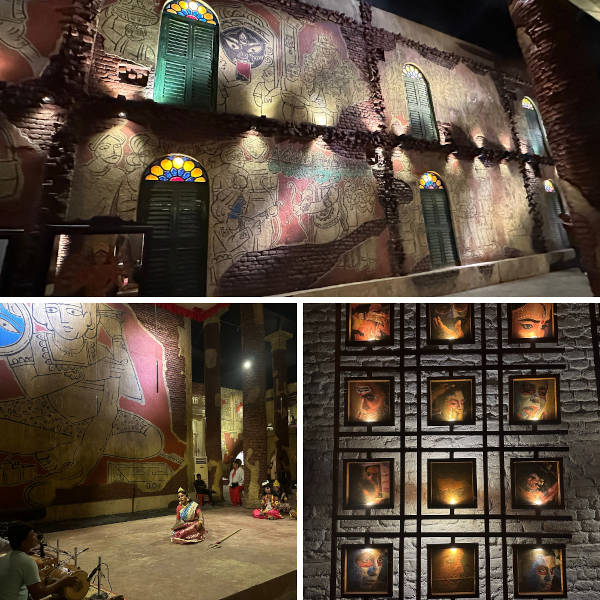
Of course the main road that you drive down has all the streetlights replaced with bright and blingy pink, orange, green and ochre lights that put you immediately in a festive rural setting. As you enter, you come across a few practitioners putting on makeup. Of course, their mirror is an empty oval and they’re really facing you. Happily they’ll break the fourth wall to pose for photographs or wave at you. One, a chappie with six fingers on one hand, will very gleefully sneak this into your photograph when he can.
You enter into a large courtyard. All around you are high-quality murals depicting stories of gods and goddesses. And in the centre courtyard, accompanied by music, a full fledged jatra (the English word pantomime is the closest to use, but it may be less right) plays out before you. The players are involved and often walk in and out of the audience. People come and go, but they sing, dance and orate with vigour. Behind them are a full two stories of players. Some fanning themselves, some posing. One, a Kali, guards the entrance to what appears to be a green-room.
The pratima is grey and beautiful. The art that adorns the massive walls is also a distinct style throughout. Both of these have a modern touch that contrast the timeless Bahurupi actors. The walls are a semi finished, or perhaps it’s a dilapidated courtyard, whose rooms seemed to be torn down to house the drama in the centre. It helps, because crags of brick catch the light like so much cracking caked makeup.
The dedication to the craft cannot be overstated. Of course none of our images or videos are going to do it much justice, so I’m attaching the official YouTube video of the pandal here.
1. Dum Dum Tarun Dal (Pradip Das)
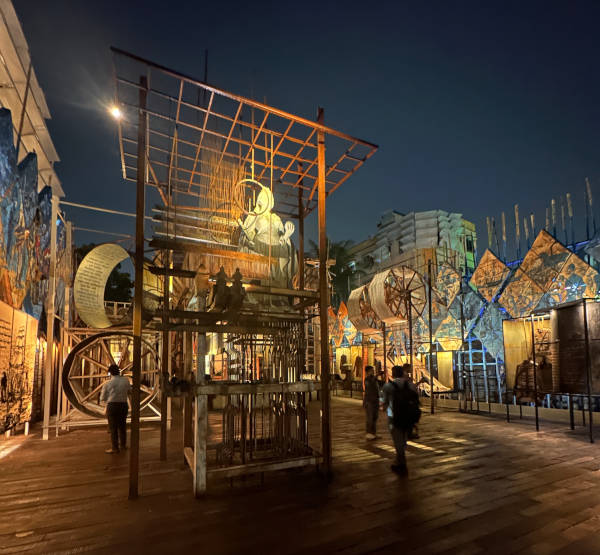
Once again culture keeper Pradip Das hits us with an emotional whammer. The theme is Sada ar Nil. Sada, having many connotations (including the Indic word for straightforward), is white. And tells many tales leading in, tales of mourning, and tales of Islamic Bengali muslin, the lost cloth so fine, that the words used to describe it, baft hawa, literally mean woven air. Nil is blue, and Pradip ruminates on blues music, and Picasso’s blue period, before reminding us of the greed imbibed in the harvests of the indigo plant, or blue gold as the British Raj called it.
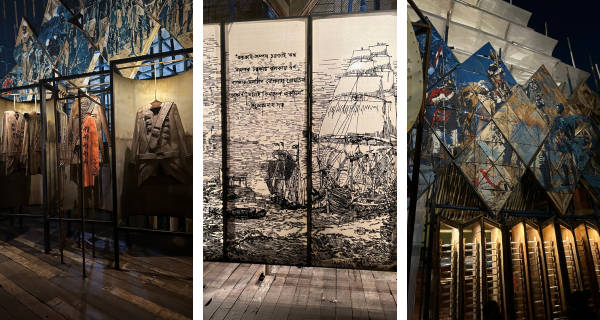
Exquisitely painted wooden panels take us through the history lesson. It tells the story of Bengal, shown in two colours, blue and white. It tells us of the indigo trade, the exploitation, the taxation and the enforcement, and ultimately the uprising. It tells us of white, purity and innocence, lavished by the royal courts of Europe, tipping the fine balances of economy wayward, till a bitter and cruel colonial power breaks the looms and amputates the arms of the muslin makers for good measure. Thus the ancient 16-step muslin making process is lost to violence and time. Red is used on the panels for exactly two subject matters. Red for British redcoats, and red for Indian blood.
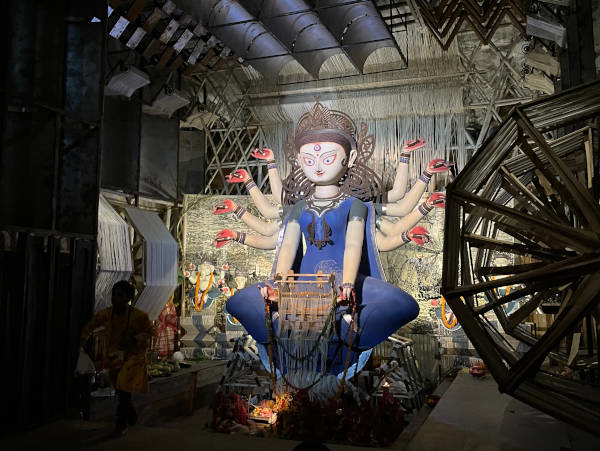
A sculpture towers above us in ivory. The stern figure of Victoria Regina, grasping her sovereign orb like her grasp on the globe. She is surrounded by draped empty redcoats hanging at attention, made of rust coloured iron. Behind us is a door askew with the Union Jack fallen asunder. Almost too conveniently you realise, when surrounded by the tri-chrome colour scheme of the rest of the pandal, that the Union Jack is white splashed on a base of blue, with red carved through the heart of it. In the centre a man (a real man) is weaving on a gigantic loom.
The Durga too is white skinned and blue-draped, her hands red. In her front two hands, she holds a loom, and in her other eight, where traditionally different weapons would be placed, are the shuttles of looms. Behind her on a vast embroidery, British ships are a-sail. Perhaps that was the asura, with whom war was waged on multiple fronts; the prowess of artisanship, the efficiency of economy, the violence of revolution, and peacefulness of protests.
Before you exit, a story is embroidered white on white. A grandmother who once had a muslin saree as an heirloom, soft as air, that pulled through a ring to prove its quality. When it tore, it was made into handkerchiefs and distributed amongst the family, and was later lost. In the dawn, she goes to pray, it says, and searches by touch for something between the morning air and the dew to pull through her ring once more.
♦¤♦¤♦¤♦
This, ladies and gentlemen, is Durga Puja in 2024. If you ever found yourself wondering why the average Bengali is so passionate, or artistic, or dogged, perhaps knowledge of the fact that the greatest art festival, open to sweepers and artists, politicians and doctors, advertisers and journalists alike, fed something into our veins that we cannot now look past. This was an oddly quiet year. Odd because usually Bengalis have a lot to say, and this year, for the most part it was unsaid. But sometimes, when a person has a lot to say, their silence can be deafening.
